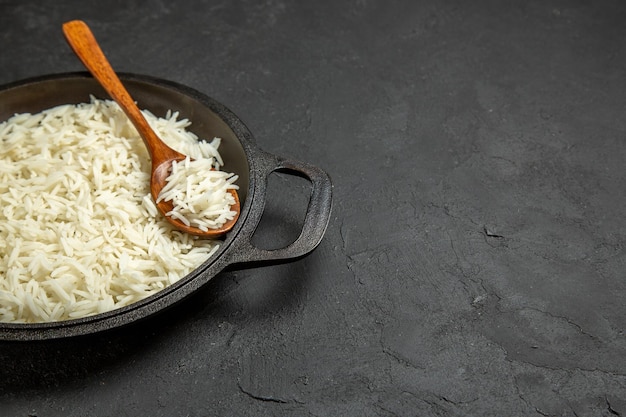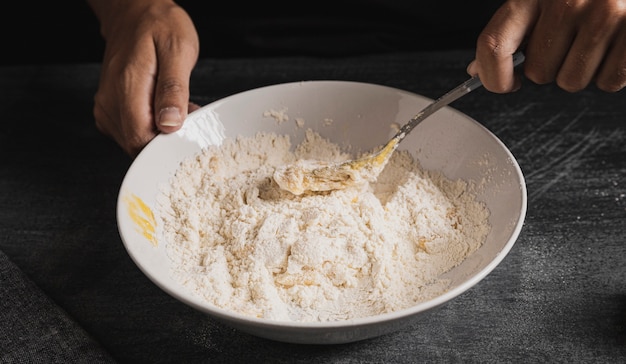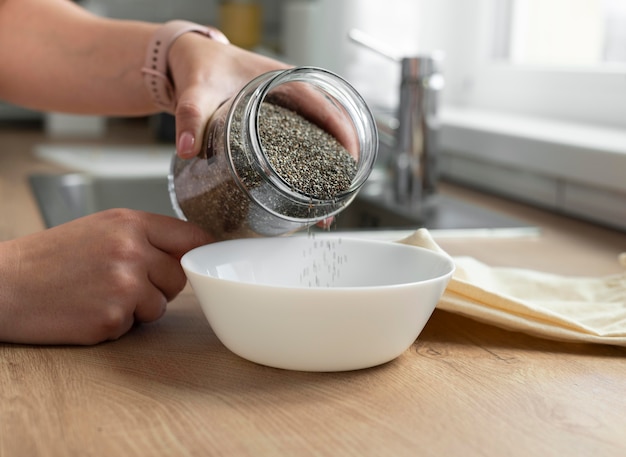(Part 1) The Rice Cooker: Your New Kitchen BFF

Okay, I used to be a stovetop rice-cooking sceptic. I'd spend ages watching the pot, convinced I had the perfect timing, only to end up with either a mushy mess or a dry, crunchy disaster. That is, until I got myself a rice cooker. It's honestly a game changer.
Forget the endless stirring, the anxiety of watching the clock, and the inevitable burnt pot situation. The rice cooker does all the work for you, freeing up your time and, more importantly, your sanity. It's like having a little kitchen robot that just knows how to do rice perfectly. Imagine: you can be reading a book, catching up on your emails, or even just relaxing while your rice cooks to perfection. No more standing over the stove, no more burning worries!
Why Choose a Rice Cooker?
Now, before you dismiss the rice cooker as just another gadget gathering dust in your kitchen, let me give you a few reasons why it's worth the investment.
- Effortless and hands-free: Pop in the rice, water, and press a button. That's it. No more babysitting the stovetop or worrying about burning the bottom of the pot.
- Consistent results: Say goodbye to inconsistent results! With a rice cooker, you can expect perfectly cooked rice every single time. No more dry rice, no more mushy rice, just fluffy, delicious perfection.
- Time-saving: Imagine the freedom! You can be doing something else while the rice cooks. Read a book, catch up on your emails, or even just relax. No more standing over the stove.
- Variety of rice types: Most rice cookers can handle different types of rice, from long-grain to brown rice, even quinoa and other grains. You can experiment with different varieties and find your favorite.
- Easy clean-up: The inner pot is usually non-stick, making it a breeze to clean. Just wipe it down with a damp cloth, and you're good to go.
choosing the right rice Cooker
Okay, so you're sold on the rice cooker, but with so many different models out there, how do you choose the right one for you? Well, here are a few factors to consider:
- Size: If you're cooking for one or two, a smaller rice cooker will be more than enough. But if you've got a larger family or frequently entertain, you'll need a larger capacity. You don't want to be constantly refilling the pot!
- Features: Some rice cookers come with extra features, like a steamer basket for cooking vegetables, a warming function to keep your rice warm after cooking, or even a multi-cook setting for making other dishes. These extras can be handy, but think about what features you actually need.
- Price: Rice cookers come in a range of prices, so set a budget and stick to it. Remember, you don't need the most expensive model to get great results.
(Part 2) The Basics of rice cooking

Now that you've got your trusty rice cooker, let's talk about the basics of cooking perfect rice. It's actually quite simple, but there are a few key things to remember.
1. The Right Ratio
The most important thing is to get the water-to-rice ratio right. It's basically the key to achieving that perfect texture. For most types of rice, the general rule of thumb is a 1:1 ratio. This means that for every cup of rice, you'll need one cup of water.
Now, you might be thinking, "Isn't that a bit basic?" And you'd be right, if all rice were created equal. But, as you'll see in a bit, different rice types have different moisture needs. This is where a little bit of experimentation comes in handy.
2. Measuring Up
Don't just grab any old measuring cup and go wild! When it comes to rice cooking, precision is crucial. Use a proper rice measuring cup, which is designed specifically for rice. These cups are slightly larger than standard measuring cups, which helps to ensure you're using the correct amount of rice. Why is this so important? It helps ensure that the water-to-rice ratio is perfect, so you get consistently great results.
3. The Rinse
Rinsing your rice is a crucial step that many people overlook. It helps to remove excess starch, which can make the rice sticky and clumpy. To rinse your rice, simply place it in a fine-mesh strainer and run cold water over it until the water runs clear. The water will become cloudy as the starch washes off, so keep rinsing until it runs clear.
4. Choosing Your Rice
Not all rice is created equal. Different types of rice have different cooking times and textures. For example, long-grain rice is known for its fluffy texture and distinct grains, while short-grain rice is sticky and often used for sushi.
Here's a quick rundown of some popular rice types and their characteristics:
| Rice Type | Characteristics | Best Uses |
|---|---|---|
| Long-grain | Fluffy, separates easily | Stir-fries, pilafs, side dishes |
| Medium-grain | Slightly sticky, good for clumping | rice bowls, sushi |
| Short-grain | Very sticky, ideal for sushi | Sushi, rice balls |
| Brown rice | Chewier, nutty flavor | Side dishes, salads |
| wild rice | Nutty flavor, chewy texture | Salads, soups |
| Quinoa | Slightly nutty flavor, fluffy texture | Salads, side dishes |
Experiment with different types of rice to find your favorite.
(Part 3) Mastering the Rice Cooker

Okay, you've got your rice, you've rinsed it, and you've measured everything out perfectly. Now it's time to put it all together in the rice cooker.
1. The Inner Pot
Place the rinsed rice into the inner pot of your rice cooker.
2. Adding the Water
Carefully pour the appropriate amount of water into the inner pot. Remember that 1:1 ratio, but remember, you might need to adjust slightly depending on the rice type.
Here are some general guidelines for water-to-rice ratios:
- Long-grain rice: 1:1.25 (1 cup rice to 1.25 cups water)
- medium-grain rice: 1:1 (1 cup rice to 1 cup water)
- Short-grain rice: 1:1 (1 cup rice to 1 cup water)
- Brown rice: 1:1.5 (1 cup rice to 1.5 cups water)
- Wild rice: 1:3 (1 cup rice to 3 cups water)
- Quinoa: 1:1.5 (1 cup quinoa to 1.5 cups water)
It's important to note that these are just general guidelines. You may need to adjust the water-to-rice ratio depending on the specific brand of rice and your own preferences.
3. The Cook Cycle
Close the lid of the rice cooker and select the appropriate cooking cycle. Most rice cookers have a setting for white rice, brown rice, and other types of grains. If your rice cooker doesn't have a specific setting for the type of rice you're using, just choose the closest setting.
4. Waiting Game
Now comes the best part: relax! Let the rice cooker do its thing. You can leave it alone and come back later. The rice cooker will automatically switch to a warming mode when the rice is cooked. This is a handy feature that keeps your rice warm and fluffy, so you can enjoy it whenever you're ready.
Once the rice cooker has finished cooking, let the rice sit for a few minutes in the warming mode. This will allow the rice to steam and absorb any remaining moisture, resulting in perfect, fluffy rice.
(Part 4) Beyond the Basics
So, you've mastered the art of cooking basic rice. Now let's explore some exciting ways to level up your rice game.
1. The "Lazy" Method
For those times when you're really short on time, there's the "lazy" method. Just add the rice and water to the rice cooker as usual, but don't rinse the rice first. The rice will still cook perfectly, even with the excess starch. This is a great option for those nights when you want a quick and easy meal.
2. The "Fancy" Method
For a more refined rice, try adding a bit of salt or a pinch of sugar to the water before cooking. This will enhance the flavor of the rice and create a slightly more flavorful base for your dishes. You can also experiment with adding spices like cinnamon, cardamom, or star anise to the water for a fragrant rice.
For a truly gourmet touch, try adding a sprig of fresh herbs to the water, like rosemary or thyme. Just be sure to remove the herb before serving.
3. The "Multi-Cooker" Method
Many rice cookers come with extra features, like a steaming basket. Use this to cook vegetables alongside your rice. Simply place the vegetables in the steaming basket, and they will cook in the steam from the rice. It's a great way to make a quick and easy meal.
Think about the possibilities! You can steam broccoli, asparagus, carrots, or even fish while your rice cooks. This is a perfect way to create a complete meal in one pot, making meal prep a breeze.
(Part 5) rice recipes
Now that you've got the perfect rice down, let's talk about some delicious things you can do with it.
1. The Classic fried rice
Who doesn't love a good fried rice? Combine your cooked rice with chopped vegetables, scrambled eggs, and your favorite sauce for a quick and satisfying meal.
Here's a simple fried rice recipe:
- 1 cup cooked rice
- 1 tablespoon vegetable oil
- 1/2 cup chopped onion
- 1/2 cup chopped carrots
- 1/2 cup chopped peas
- 2 eggs, beaten
- 1/4 cup soy sauce
- 1 tablespoon sesame oil
Heat the oil in a wok or large skillet. Add the onion, carrots, and peas, and cook for 3-4 minutes, or until softened. Push the vegetables to one side of the pan, and add the eggs. Scramble the eggs until cooked through. Combine the vegetables and eggs with the rice, and add the soy sauce and sesame oil. Cook for 2-3 minutes, or until heated through.
2. The Comforting Rice Bowl
Rice bowls are a great way to get creative with your leftovers. Top your rice with roasted vegetables, grilled chicken or fish, and a drizzle of sauce.
Here's a simple rice bowl recipe:
- 1 cup cooked rice
- 1/2 cup roasted vegetables (such as broccoli, carrots, sweet potatoes)
- 1/4 cup grilled chicken or fish
- 1/4 cup your favorite sauce (such as teriyaki sauce, sriracha mayo)
Combine the rice, vegetables, protein, and sauce in a bowl. You can customize your rice bowl with any toppings you like, such as avocado, shredded cheese, or a fried egg.
3. The Sweet and Savory rice pudding
For a sweet treat, try making a rice pudding. Combine cooked rice with milk, sugar, and spices like cinnamon and vanilla. You can even add a touch of rum for an extra kick.
Here's a simple rice pudding recipe:
- 1 cup cooked rice
- 2 cups milk
- 1/4 cup sugar
- 1 teaspoon vanilla extract
- 1/2 teaspoon cinnamon
Combine all ingredients in a saucepan. Bring to a simmer, then reduce heat to low and cook for 15-20 minutes, stirring occasionally. The pudding should thicken and become creamy. Serve warm or chilled.
(Part 6) FAQs
Let's address some common rice cooker questions.
1. Can I cook brown rice in my rice cooker?
Yes, most rice cookers have a setting for brown rice. Just follow the same instructions as for white rice, but check your rice cooker's manual for the recommended cooking time. Brown rice generally takes longer to cook than white rice.
2. What if my rice is too sticky?
If your rice is too sticky, it's likely you used too much water. Next time, try reducing the amount of water by a tablespoon or two.
3. How do I keep my rice warm?
Many rice cookers have a warming function that keeps your rice warm after cooking. Just check your rice cooker's manual for instructions. The warming function is a lifesaver, especially if you're cooking for a crowd or want to enjoy your rice later.
4. What if my rice is dry?
If your rice is dry, it's likely you didn't use enough water. Next time, try adding a tablespoon or two more water.
5. Can I cook anything else in my rice cooker?
Yes, some rice cookers have a multi-cook setting that allows you to cook other dishes, like soups, stews, and even cakes. Just check your rice cooker's manual for instructions.
(Part 7) Troubleshooting
Let's face it, even the best rice cookers can have their quirks. Here are a few common problems and solutions:
1. The rice is burnt
This happens when the rice cooker is left on the warming function for too long. Make sure to switch off the rice cooker once the rice is cooked.
2. The rice is mushy
This can happen if you used too much water or if the cooking time was too long. Make sure to follow the instructions for your specific rice cooker and use the correct water-to-rice ratio. You can also try adjusting the cooking time slightly shorter the next time.
3. The rice is dry
This can happen if you didn't use enough water or if the cooking time was too short. Make sure to follow the instructions for your specific rice cooker and use the correct water-to-rice ratio. You can also try adjusting the cooking time slightly longer the next time.
4. The rice cooker isn't working
First, make sure that the rice cooker is plugged in and that the power button is on. If it's still not working, check your circuit breaker to see if it's tripped. If none of these solutions work, you may need to contact the manufacturer.
(Part 8) Final Thoughts
There you have it! My guide to achieving perfect rice every time. Remember, cooking rice doesn't have to be complicated. With a little practice and a trusty rice cooker, you'll be enjoying fluffy, delicious rice in no time.
So, what are you waiting for? Get cooking! Enjoy the simplicity and the satisfaction of knowing you've mastered the art of cooking the perfect rice. And remember, there's no shame in using a rice cooker – it's a friend to any home cook, making the journey towards culinary greatness a little bit easier.
Everyone is watching

Prime Rib Roast Cooking Time Chart: Per Pound Guide
Cooking TipsPrime rib roast. Just the name conjures images of lavish dinners, crackling fires, and hearty laughter. It’s ...

How Long to Bake Potatoes in the Oven (Perfect Every Time)
Cooking TipsBaked potatoes are a staple in my kitchen. They're incredibly versatile, delicious, and surprisingly easy to m...

Perfect Rice Every Time: The Ultimate Guide to Cooking Rice
Cooking TipsAs a self-proclaimed foodie, I've always been a bit obsessed with rice. It's the foundation of countless cuisi...

The Ultimate Guide to Cooking Asparagus: Tips, Techniques, and Recipes
Cooking TipsAsparagus. The mere mention of this spring delicacy conjures up images of vibrant green spears, crisp and burs...

Ultimate Guide to Cooking the Perfect Thanksgiving Turkey
Cooking TipsThanksgiving. Just the word conjures up images of overflowing tables laden with delicious food, the scent of r...
